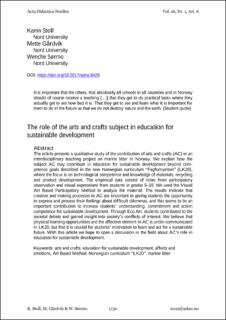| dc.contributor.author | Stoll, Karin | |
| dc.contributor.author | Gårdvik, Mette | |
| dc.contributor.author | Sørmo, Wenche | |
| dc.date.accessioned | 2022-11-11T10:23:10Z | |
| dc.date.available | 2022-11-11T10:23:10Z | |
| dc.date.created | 2022-03-15T15:26:59Z | |
| dc.date.issued | 2022 | |
| dc.identifier.citation | Stoll, K., Gårdvik, M., & Sørmo, W. (2022). The role of the arts and crafts subject in education for sustainable development. Acta Didactica Norden, 16(1), 30. doi: | en_US |
| dc.identifier.issn | 2535-8219 | |
| dc.identifier.uri | https://hdl.handle.net/11250/3031366 | |
| dc.description.abstract | AbstractThe article presents a qualitative study of the contribution of arts and crafts (AC) in an interdisciplinary teaching project on marine litter in Norway. We explain how the subject AC may contribute in education for sustainable development beyond com-petence goals described in the new Norwegian curriculum “Fagfornyelsen” (LK20), where the focus is on technological competence and knowledge of materials, recycling and product development. The empirical data consist of notes from participatory observation and visual expressions from students in grades 5–10. We used the Visual Art Based Participatory Method to analyse the material. The results indicate that creative and making processes in AC are important in giving students the opportunity to express and process their feelings about difficult dilemmas, and this seems to be an important contribution to increase students’ understanding, commitment and action competence for sustainable development. Through Eco Art, students contributed to the societal debate and gained insight into society’s conflicts of interest. We believe that physical learning opportunities and the affective element in AC is under-communicated in LK20, but that it is crucial for students’ motivation to learn and act for a sustainable future. With this article we hope to open a discussion in the field about AC’s role in education for sustainable development. Keywords: arts and crafts, education for sustainable development, affects and emotions, Art Based Method, Norwegian curriculum “LK20”, marine litterActa Didactica NordenVol. 16, Nr. 1, Art. 6K. Stoll, M. Gårdvik & W. Sørmo1/302022©adno.no | en_US |
| dc.description.abstract | The role of the arts and crafts subject in education for sustainable development | en_US |
| dc.language.iso | eng | en_US |
| dc.publisher | Acta Didactica Norden | en_US |
| dc.relation.uri | https://journals.uio.no/adnorden/article/view/8429/8119 | |
| dc.rights | Attribution-NonCommercial-NoDerivatives 4.0 Internasjonal | * |
| dc.rights.uri | http://creativecommons.org/licenses/by-nc-nd/4.0/deed.no | * |
| dc.title | The role of the arts and crafts subject in education for sustainable development | en_US |
| dc.title.alternative | Kunst og håndverksfagets rolle i utdanning for bærekraftig utvikling | en_US |
| dc.title.alternative | The role of the arts and crafts subject in education for sustainable development | en_US |
| dc.type | Peer reviewed | en_US |
| dc.type | Journal article | en_US |
| dc.description.version | publishedVersion | en_US |
| dc.rights.holder | © 2022 Acta Didactica Norden | en_US |
| dc.subject.nsi | VDP::Samfunnsvitenskap: 200::Pedagogiske fag: 280::Fagdidaktikk: 283 | en_US |
| dc.source.pagenumber | 30 | en_US |
| dc.source.volume | 16 | en_US |
| dc.source.journal | Acta Didactica Norden (ADNO) | en_US |
| dc.source.issue | 1 | en_US |
| dc.identifier.doi | 10.5617/adno.8429 | |
| dc.identifier.cristin | 2009996 | |
| dc.source.articlenumber | 6 | en_US |

